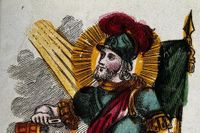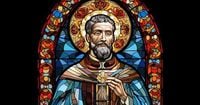On May 4, 2025, the Catholic Church honors several saints, with the most notable being Saint Florian of Lorch, a martyr from the early centuries of Christianity who is revered as the patron saint of firefighters and various cities, particularly in Central Europe. His story, filled with courage and dedication, continues to inspire many even after 1,700 years.
Saint Florian was born around the year 250 in Aelium Cetium, a Roman city that corresponds to present-day Sankt Pölten, Austria. He served as a commander in the Roman army within the province of Noricum, which includes parts of modern Austria. Florian was responsible for organizing a specialized unit to combat fires, a role that would later lead to his recognition as the patron saint of firefighters.
During the intense persecutions against Christians under the emperors Diocletian and Maximian, Florian refused to participate in the pagan sacrifices demanded by the emperor. This act of defiance resulted in his arrest and subsequent execution. Initially sentenced to be burned alive, Florian's steadfastness led to a different fate; he was thrown into the Enns River with a millstone tied around his neck. His body was later recovered by fellow Christians and buried near Lorch.
Florian's legacy as a symbol of strength and protection is particularly celebrated in Austria and Poland, where he is venerated as a national patron saint. His image is often depicted with a bucket of water, recalling a legend that he extinguished a fire with just a single bucket. Since 2004, part of his relics have been housed in the Cathedral of Saint Michael the Archangel and Saint Florian Martyr in Krakow, a testament to a devotion that has spanned centuries.
On this day, the Church also commemorates Saints Juan Houghton, Roberto Lawrence, and Agustín Webster, three English presbyters who were martyred in the 16th century. They were executed on May 4, 1535, for their refusal to sign the Act of Supremacy, which acknowledged the king as the head of the Church of England. Their steadfast commitment to their faith and the authority of the Pope cost them their lives, marking the beginning of a severe persecution against Catholics that would last for decades. These men were canonized by Pope Paul VI in 1970 as part of the Forty Martyrs of England and Wales.
Another significant figure remembered on May 4 is Blessed Juan Martín Moyë, an 18th-century French priest known for his dedication to education and social promotion among the poor, especially girls in rural areas. He founded the Congregation of the Sisters of Providence, which focused on teaching and caring for the needy. His missionary work extended to China, a remarkable endeavor for his time. Moyë passed away in 1793 and was beatified by Pope Pius XII in 1954. His legacy continues in the many educational institutions that carry his name and follow his charism.
In addition to these notable saints, the Church commemorates several others on May 4, including Saints Agapio and Secundino, bishops and martyrs from Cirta, Algeria, who were martyred during the persecution under Emperor Valerian around 258 or 259, and Santa Antonina of Nicea, who was martyred in the 3rd or 4th century. San Silvano de Gaza and 39 companions, who also faced martyrdom, are included in today’s celebrations, as well as Blessed Ladislaus of Gielniow, a priest.
The onomastics celebrated today extend beyond just the aforementioned figures. People named José María Rubio, Afra de Brescia, Antonina de Nicea, Ciriaco, Curcódomo, Gotardo de Hildesheim, Ricardo Reynolds, and Silvano de Gaza also commemorate their saints. The Catholic tradition of celebrating the feast days of saints is a long-standing practice, allowing the faithful to remember and reflect on the exemplary lives of these individuals.
Historically, the Church has designated specific days in the calendar to honor each saint, creating a rich tapestry of remembrance throughout the year. The practice of naming children after saints on their feast days has deep roots, intertwining personal identity with spiritual heritage.
As the Church continues to recognize and celebrate these figures, it reinforces the values of fidelity and integrity that they embodied, inviting the faithful to reflect on their own lives in light of these examples. The stories of these saints serve not only as historical accounts but also as opportunities for spiritual growth and inspiration.
In summary, the celebration of May 4 is a profound reminder of the courage and faith of those who stood firm in their beliefs, often at the cost of their lives. The legacy of Saint Florian, along with the other saints commemorated today, continues to resonate with many, encouraging a spirit of resilience and devotion within the Christian community.





